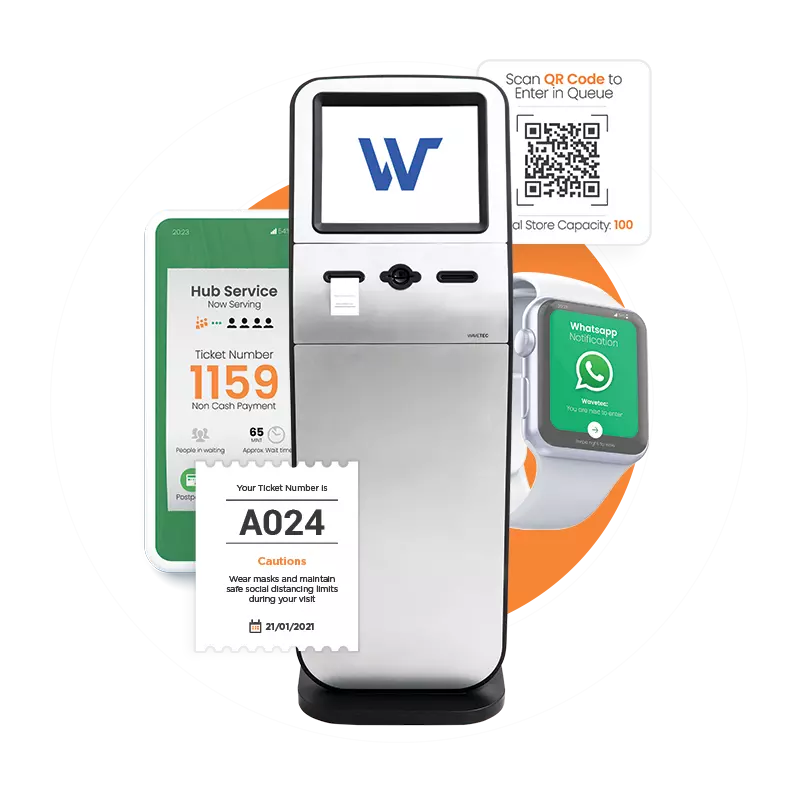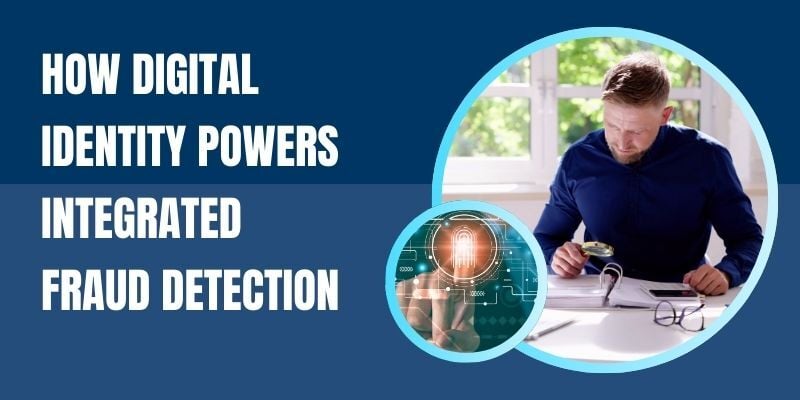Self-service kiosks are now a familiar sight in retail stores, quick service restaurants, hospitals, and transportation centers. These machines help people place orders, check in, make payments, or find information without needing assistance.
As the need for faster and more convenient services increases, many businesses are opting for smarter kiosk solutions.
One important factor improving how these kiosks work is the use of 5G and edge computing. These technologies offer faster connectivity, quicker response times, and more stable performance.
By processing data closer to where it is collected, kiosks can respond in real time, even during busy hours or in locations with limited internet access.
The role of 5G and edge computing in self-service kiosks includes enhanced reliability, improved security, and the ability to continue operating during network disruptions. This helps businesses maintain service quality and reduce downtime.
As self-service continues to expand across various industries, these technologies are helping kiosks deliver faster service and maintain smoother day-to-day operations for both users and staff.
Why 5G Matters for Kiosks
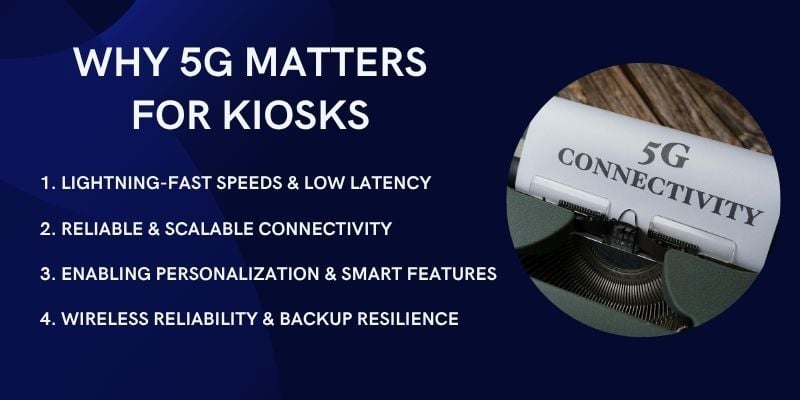
Self-service kiosks are being used across various industries, including airports, malls, fast-food chains, and hospitals. As these machines handle more tasks and support additional features, 5G allows them to operate with greater speed, stronger connections, and improved stability.
It also simplifies managing large fleets of kiosks across multiple sites, reducing delays and service disruptions.
1. Lightning-Fast Speeds and Low Latency
Speed is one of the most noticeable benefits of 5G technology. It allows kiosks to load menus, scan items, and process payments almost instantly. This makes checkouts smoother and keeps lines moving.
5G networks can reach response times as low as one millisecond, which helps the screen react the moment a customer taps it.
This speed also makes a big difference in how content is delivered. Whether it’s a video, an animated menu, or a digital map, everything feels more responsive. Customers receive what they need without delay, which helps improve the customer experience while using kiosks.
2. Reliable and Scalable Connectivity
Many kiosks are placed in busy areas, such as airports and shopping centers, where thousands of devices are connected simultaneously.
5G is built to handle this kind of load. It can support up to 1 million connected devices within a square kilometer, making it useful for kiosks at airports and other high-traffic areas.
This also makes it easier to manage large fleets of kiosks. With a steady connection, updates can be pushed out remotely, and performance can be tracked in real time.
Whether a company is running a dozen kiosks or several hundred, 5G allows them to stay connected without interruptions.
Wavetec offers self-service kiosks that make full use of this strong connectivity, allowing for seamless updates, real-time monitoring, and consistent performance even in the busiest environments.
3. Enabling Personalization and Smart Features
Many businesses now expect kiosks to offer more than just basic service. With a stable and fast connection, kiosks can support real-time features that respond directly to customers.
This might include face recognition for returning visitors, voice-based navigation, or product suggestions based on time, location, or past activity. These features help create a more personalized experience without slowing down the system.
Features like these rely on strong network performance to work smoothly. They also represent how companies are beginning to use AI in self-service kiosks to offer smarter service while reducing pressure on staff.
4. Wireless Reliability and Backup Resilience
In some places, wired internet is not always reliable or easy to install. 5G provides a strong wireless option that can serve as a backup if the main connection goes down.
This keeps the kiosk running without disruption, which is especially important in healthcare, transit, and other critical services.
For businesses using edge computing in kiosks, 5G also helps keep local processing connected to wider systems. This allows the kiosk to handle tasks locally while still sharing updates and insights with central teams in real-time.
What Edge Computing Brings
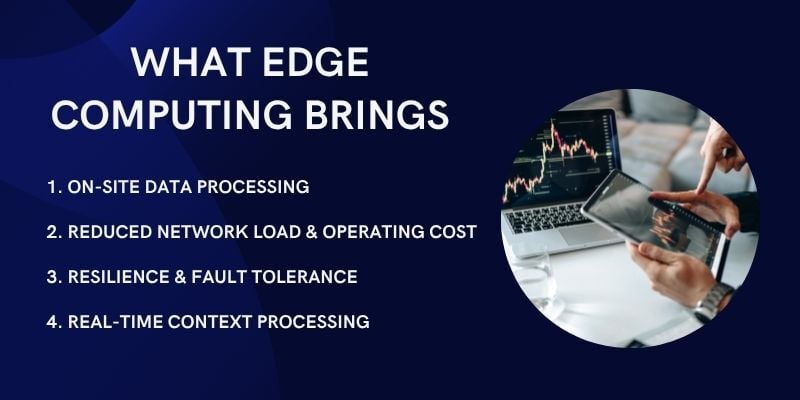
Kiosks often need to process tasks quickly and keep working even when internet connections are unstable.
Edge computing helps by moving data processing closer to the kiosk, either directly on the device or at nearby network points. This setup makes kiosks faster, more reliable, and more cost-effective to run.
1. On-Site Data Processing
Many kiosks exchange data with the cloud, which can cause delays, especially in areas with low connectivity or high traffic.
With edge computing, a kiosk can process key tasks on-site, such as verifying a user’s identity, loading menus, or handling payments. This helps reduce delays and makes the service feel more immediate.
By keeping more work local, kiosks respond more quickly and remain functional even if the network connection is dropped. In busy places like transit stations or outdoor events, this kind of real-time data processing makes a big difference.
2. Reduced Network Load and Lower Operating Cost
Sending large amounts of data to the cloud can strain networks and result in increased monthly service fees. When kiosks handle more of that work on-site, they use less bandwidth. This not only enhances speed but also reduces operating costs over time.
Some companies using edge computing have seen about a 43% drop in data transmission costs. This approach has become a practical way to reduce costs while maintaining reliable service across multiple locations.
3. Resilience and Fault Tolerance
When kiosks rely entirely on external servers, a network issue can bring them to a halt. Edge computing helps prevent that. If the primary connection fails, the kiosk can continue to function using locally stored data.
This kind of setup helps in places where reliable service is critical, like hospitals or airports. Whether it’s printing a boarding pass or confirming an appointment, the kiosk continues to function even when the internet is unavailable.
4. Real-Time Context Processing
Edge computing allows kiosks to respond to what’s happening around them. This could involve adjusting the screen layout according to the time of day or providing suggestions based on a user’s past choices or location. These features are more useful when they happen instantly, not after a delay.
In retail and banking, this approach has shown real results. One report noted a 91% reduction in processing delays when financial applications used edge computing instead of relying on remote servers.
That speed helps create smoother interactions and improves the overall customer journey.
Spending on this kind of technology is also rising. Global investment in edge computing is expected to reach nearly $378 billion by 2028, as more businesses seek to support local processing at physical locations where speed and reliability are crucial.
Combined Power of 5G and Edge Computing
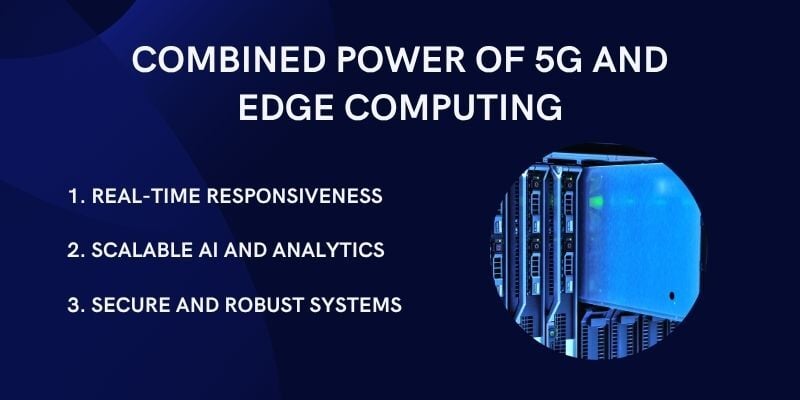
5G and edge computing work well together to enhance the performance of kiosks. While 5G gives fast and stable wireless access, edge computing handles data close to the kiosk.
This setup helps reduce delays, keeps systems running during outages, and lowers pressure on central servers.
Industries like retail, healthcare, and public transport are using this approach to support busy service areas. It helps them respond to customers more quickly and manage large numbers of kiosks across different sites without compromising speed or control.
1. Real-time Responsiveness
Customers expect self-service kiosks to work without delay. When 5G and edge computing are used together, kiosks respond quickly to user input.
A touchscreen reacts immediately, a payment processes within seconds, and a receipt prints without pause. This real-time performance streamlines operations, ensuring that services run smoothly.
Even during high foot traffic, kiosks do not lag or freeze because most of the work is handled locally. This is especially helpful in fast-paced areas, such as food courts or transit stations, where quick service enhances the overall flow and keeps customers moving.
Wavetec’s self-service kiosks are designed with this responsiveness in mind, delivering fast, smooth interactions that improve both customer experience and staff efficiency.
Faster response times are a clear example of the benefits of kiosks for both users and staff.
2. Scalable AI and Analytics
Edge computing can support real-time detection, such as recognizing a returning user or identifying a product without needing a barcode.
The results are processed on-site, and 5G is used to send summaries or alerts to central systems when needed. This setup reduces the amount of data being transferred, keeping the process fast.
As more locations add self-service, this model supports growth without slowing down the system. In retail, for example, it supports AI in self-checkout by confirming scanned items through local cameras or sensors.
Insights can be collected without adding pressure to cloud servers, which helps businesses track trends and address issues.
3. Secure and Robust Systems
Kiosks are often placed in public spaces, making it critical to maintain data security and system stability. Edge computing allows private information, such as payment details, to be processed at the kiosk without sending it to a remote server. This reduces exposure and keeps the system more controlled.
If a network problem occurs, the kiosk can still function by using local data. This makes the system more reliable in locations where network access is not guaranteed.
For teams managing a large network, this also makes deploying a kiosk easier, since service interruptions are less likely to impact the whole system. Together, edge and 5G create a more reliable setup for real-time service.
Real-World Use Cases
Here are a few strong examples of how 5G, paired with edge computing, is already enhancing kiosk functionality across transit and smart city environments.
Dallas Area Rapid Transit: Smart Transit Kiosks
Dallas Area Rapid Transit outfitted 500 interactive touchscreen kiosks with 5G-enabled connectivity and onboard edge containers for real-time video analysis and anomaly detection.
These kiosks provide security alerts, support multiple languages, and deliver local promotions and transit updates. All processing occurs close to the device, while 5G ensures connections remain smooth even during peak periods.
LinkNYC Link5G Kiosks in New York City
New York City replaced old payphones with LinkNYC kiosks that offer free Wi‑Fi, phone charging, digital maps, emergency call buttons, and two large high-definition screens.
Since July 2022, the network has rolled out Link5G versions, 32‑foot towers equipped with 5G small cells and tablets. These kiosks deliver live transit updates, city information, and high-speed downloads without buffering.
Challenges & Considerations

Even the best 5G kiosk solutions face real-world hurdles. Businesses looking to deploy kiosks at scale must address coverage, hardware, and upgrade challenges earlier rather than later.
1. Coverage Gaps
5G performs well in open areas but struggles with solid walls and long distances indoors. To maintain strong indoor connectivity, especially in large venues such as shopping centers or transit hubs, companies often install numerous small cells.
According to Rethink RAN Research, private 5G small cell deployments are projected to reach 1.56 million by 2027. Without this infrastructure, kiosk performance could suffer, resulting in increased load times or network dropouts.
2. Legacy Upgrades
Many kiosks in service today still rely on older mobile networks like 3G and early 4G. Since major carriers, including AT&T, Verizon, and T-Mobile, completed their 3G network shutdowns in 2022, any kiosks that haven’t been upgraded since then are either offline or running with limited support.
Even early-generation 4G hardware may no longer meet the speed or security standards needed for modern services.
Upgrading these units involves more than swapping a modem. Some kiosks may need full hardware replacements to support newer modules, local processing, or 5G compatibility. This takes time, budget, and coordination across multiple sites.
A phased rollout helps reduce disruption, starting with high-traffic or high-priority locations before expanding network-wide.
3. Edge Hardware Requirements
If kiosks are expected to analyze video, perform biometric scans, or adjust content in real-time, they require more powerful on-site processors, such as specialized inference chips or compact edge servers.
This hardware upgrade adds complexity, as units must be properly cooled and maintained. Although these enhancements support advanced features, they also increase initial setup costs and ongoing maintenance requirements.
Market Outlook
Self-service technology is becoming an important part of how businesses serve customers. The global market for these solutions is expected to reach $53.32 billion in 2025, with projections indicating it could grow to $131.83 billion by 2034.
The increase is linked to a rising need for faster, more independent service options in retail, transit, banking, and other sectors.
A big part of this expansion is tied to advances in hardware and connectivity. With stronger edge processors and widespread 5G networks, kiosks can now handle more tasks independently.
These upgrades make it easier to run secure payments, display real-time content, and respond quickly without relying heavily on central servers.
As these improvements continue, more industries, including retail, banking, transit, and healthcare, are planning new rollouts or expanding their existing networks.
Businesses that invest early in 5G and edge-based systems are more likely to meet rising expectations for speed, reliability, and ease of use in self-service.
Conclusion
Integrating 5G and edge computing into self-service kiosks offers various benefits. It shortens wait times, improves system uptime, and supports faster, more secure service.
With local data processing, kiosks can respond quickly and continue working even when cloud access is limited. In busy environments such as retail outlets, transportation hubs, and healthcare centers, this leads to smoother operations and improved customer interactions.
As older networks and devices are phased out, businesses should begin preparing for upgrades. This includes updating connectivity and adding edge hardware where needed.
A step-by-step rollout allows companies to modernize without disrupting service, helping them stay competitive as demand for self-service continues to rise across industries.
BOOK A FREE DEMO
